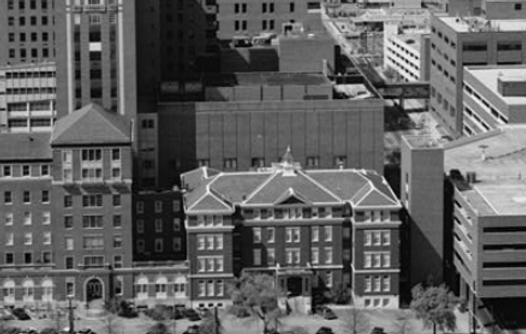Birmingham Medical College
Birmingham, Alabama
1894-1912
E-Travel
The University of Alabama-Birmingham Digital Archives has photographs, commencement programs, and other materials from Birmingham Medical College. The Birmingham Age-Herald covered some news from the campus. The Mask, a publication of Kappa Psi Fraternity, carried a regular report from the school. The image of the B.M.C. building (right) is from Bham Wiki, downloaded 9/25/2024.

History
The Age-Herald lists B.M.C. as "another offspring of the Magic City's Commercial Club." A proprietary school, it had a faculty of fourteen local physicians when it opened on October 2, 1894. Initially, the curriculum required three years of six-months each. By 1898 the program had been increased to meet the Southern Medical Association guideline of four years.
The Birmingham Dental College, a partner with B.M.C. from the beginning, merged with B.M.C. in 1910. A pharmacy division was added; so the school officially became Birmingham Medical, Dental and Pharmacy College.
The 1909 Flexner report was not kind to B.M.C. It noted the "nominal" entrance requirements (14 high school credits), and the annual maintenance fund of only $14,550. The report was also critical of the building, noting the absence of physiological, pharmacological and clinical labs, as well as a library and a museum. It noted that Hillman Hospital provided students with practice dealing primarily with accidents and gunshot wounds.
In both 1910 and 1912 the American Medical Association gave B.M.C low marks in three areas: admissions policies, the lack of full-time faculty, and the poor conditions of the teaching facility. The evaluation concluded, "We sincerely wish that some miracle might happen which would bring for you the needed ideals, the money necessary and a close union with some strong university which would imbue you with the thorough, university methods of teaching."
..
B.M.C. then ceased to exist as a proprietary school, its buildings being deeded to the state. On October 1, 1913, the Graduate Medical School of Alabama opened, utilizing the facilities of Birmingham Medical College, including the use of Hillman Hospital and the new Free Dispensary. This arrangement continued through 1915, when all B.M.C. students graduated.
Newspapers show little extra-curricular activity. Most B.M.C. students were members of one of two fraternities--Kappa Psi and Phi Chi. In 1911 The Mask shows that these provided weekly (later bi-weekly) meetings and an annual banquet. It also notes, "We constantly have the ladies visit us." An 1899 graduate of B.M.C., Elizabeth White, was the second female M.D. in Alabama.

BMC students in an anatomy laboratory in 1905. Image used by permission of U.A.B. Archives, University of Alabama at Birmingham.
Bricks and Mortar
B.M.C. opened in a renovated Lunsford Hotel on 21st Street in the heart of the city. Lunsford was a five-story terra cotta building containing a free dispensary for the "indigent poor" and a surgical theater. Students did clinical work at the Charity Hospital, later re-named Hillman Hospital. After experiencing a number of transitions, the Lunsford was razed in 2009.
The over-crowded Hillman Hospital laid the cornerstone for a new building in 1902 at the corner of 21st Street and F Avenue. At the same time B.M.C. built an adjoining four-story brick structure. In addition to lecture halls, it contained four labs for chemistry, pathology, histology. and bacteriology. The B.M.C. staff assumed medical and surgical control of Hillman.
The 1902 Hillman Hospital, called "Old Hillman," remains today as part of the UAB hospital complex. The B.M.C. building is no longer a part of the structure.

"Old Hillman" Hospital (center) sits amid today's University of Alabama-University of Alabama at Birmingham hospital complex. The Birmingham Medical College building was to the right and behind "Old Hillman." Retrieved from Library of Congress
http://www.loc.gov/pictures/item/al0971.photos.046195p/ Accessed 2-15-2017.
Sports
School colors: possibly Blue and Gold--these colors appear in one of the commencement programs
College Football Data Warehouse lists only one game for B.M.C.--a 59-0 loss to Albertville Agricultural School in 1911. The Age-Herald lists two other losses that season: 53-0 to Alabama Presbyterian and 71-0 to Marion Military Academy.
In an article in the Birmingham Medical News, Ann B. DeBellis notes that 21 graduates of B.M.C. had played college football.
The Mask shows a more complete picture. It notes that in 1910, with faculty blessing, students formed an Athletic Committee which hired a coach. Subsequent issues note that the school's baseball team defeated Howard College and that the school's cross country team was to participate in the Birmingham Athletic Club meet.
Note: Images are used in accordance with their “terms of use” as I understand those terms. Recopying or republishing these images may be restricted or forbidden.